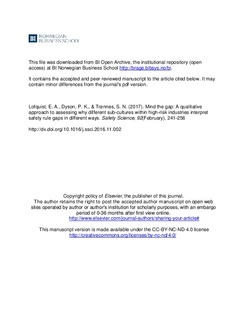| dc.description.abstract | Measuring the distance between the performance of safety rules as imagined and safety rules as enacted in high-risk environments has been an area of great interest and debate in recent years. Yet a significant gap in our understanding remains. Some authors have even advised us to “stop bitching about the gap” and start closing it (Hale and Borys, 2013a, p. 218). In this paper, we follow this call by investigating the relationship between safety rules as imagined, and enacted, in a rule-driven organization working in the oil and gas industry in Norway. Specifically, we investigate how three different sub-cultures within the organization: the management culture, the engineering culture, and the operations culture - make sense of safety rules at their respective levels, and why their interpretations of the gaps created by these same rules, are different. These differences lead to different levels of rule enactment. Using a case study approach, we found that how employees’ were engaged in the rule creation process led to different levels of psychological ownership, and this, in turn, led to different levels of rule enactment. We also found that these distinct occupational sub-cultures use different sensemaking approaches in understanding safety rules, and that the resultant differences in understanding directly affects both the understanding of the gap that exists between rules as imagined and rules as enacted, leading to different levels of rule compliance. | nb_NO |
